【免费下载】牛津初中英语教案
牛津初中英语教案
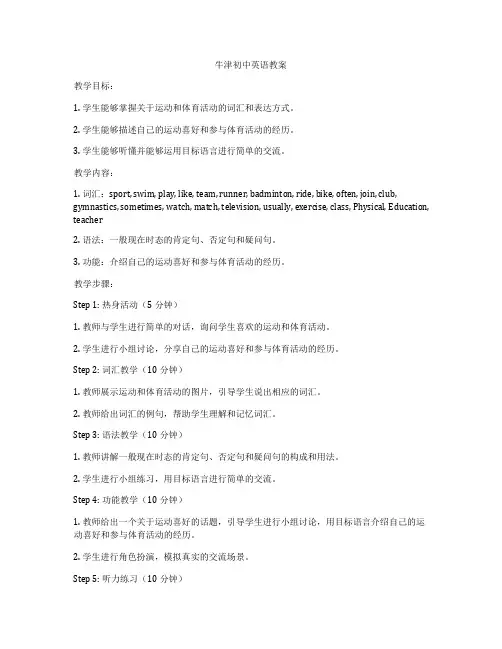
牛津初中英语教案教学目标:1. 学生能够掌握关于运动和体育活动的词汇和表达方式。
2. 学生能够描述自己的运动喜好和参与体育活动的经历。
3. 学生能够听懂并能够运用目标语言进行简单的交流。
教学内容:1. 词汇:sport, swim, play, like, team, runner, badminton, ride, bike, often, join, club, gymnastics, sometimes, watch, match, television, usually, exercise, class, Physical, Education, teacher2. 语法:一般现在时态的肯定句、否定句和疑问句。
3. 功能:介绍自己的运动喜好和参与体育活动的经历。
教学步骤:Step 1: 热身活动(5分钟)1. 教师与学生进行简单的对话,询问学生喜欢的运动和体育活动。
2. 学生进行小组讨论,分享自己的运动喜好和参与体育活动的经历。
Step 2: 词汇教学(10分钟)1. 教师展示运动和体育活动的图片,引导学生说出相应的词汇。
2. 教师给出词汇的例句,帮助学生理解和记忆词汇。
Step 3: 语法教学(10分钟)1. 教师讲解一般现在时态的肯定句、否定句和疑问句的构成和用法。
2. 学生进行小组练习,用目标语言进行简单的交流。
Step 4: 功能教学(10分钟)1. 教师给出一个关于运动喜好的话题,引导学生进行小组讨论,用目标语言介绍自己的运动喜好和参与体育活动的经历。
2. 学生进行角色扮演,模拟真实的交流场景。
Step 5: 听力练习(10分钟)1. 教师播放一段关于运动喜好的听力材料,要求学生听懂并能够回答相关问题。
2. 学生进行听力练习,教师给予指导和反馈。
Step 6: 作业布置(5分钟)1. 教师布置作业,要求学生写一篇关于自己运动喜好的短文。
教学评价:1. 观察学生在课堂上的参与程度和表现,评估学生对词汇、语法和功能的掌握程度。
牛津初中全英文教案
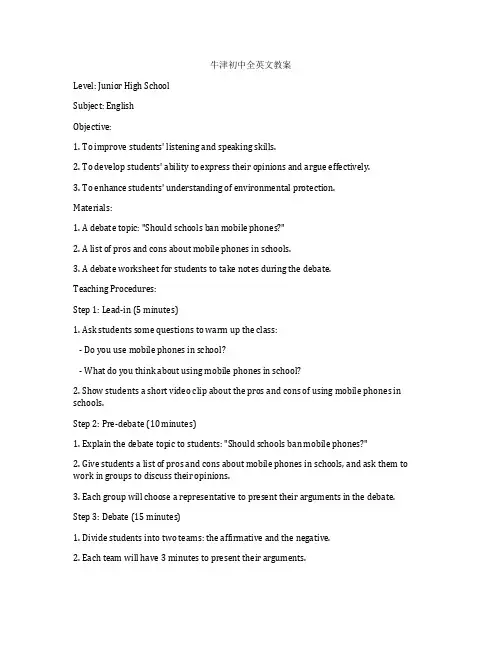
牛津初中全英文教案Level: Junior High SchoolSubject: EnglishObjective:1. To improve students' listening and speaking skills.2. To develop students' ability to express their opinions and argue effectively.3. To enhance students' understanding of environmental protection.Materials:1. A debate topic: "Should schools ban mobile phones?"2. A list of pros and cons about mobile phones in schools.3. A debate worksheet for students to take notes during the debate.Teaching Procedures:Step 1: Lead-in (5 minutes)1. Ask students some questions to warm up the class:- Do you use mobile phones in school?- What do you think about using mobile phones in school?2. Show students a short video clip about the pros and cons of using mobile phones in schools.Step 2: Pre-debate (10 minutes)1. Explain the debate topic to students: "Should schools ban mobile phones?"2. Give students a list of pros and cons about mobile phones in schools, and ask them to work in groups to discuss their opinions.3. Each group will choose a representative to present their arguments in the debate. Step 3: Debate (15 minutes)1. Divide students into two teams: the affirmative and the negative.2. Each team will have 3 minutes to present their arguments.3. After each team's presentation, the other team can ask questions or give counter-arguments.4. The teacher can also ask questions or give comments during the debate.Step 4: Post-debate (10 minutes)1. Ask students to fill out the debate worksheet, including the pros and cons they heard during the debate, and their own opinions.2. Encourage students to share their thoughts and opinions with their partners.3. Discuss the following questions with students:- What did you learn from the debate?- How can we use mobile phones responsibly in school?Step 5: Summary and conclusion (5 minutes)1. Summarize the main points of the debate.2. Emphasize the importance of using mobile phones responsibly and the potential risks of excessive use.3. Encourage students to use mobile phones as a tool for learning and communication, rather than a distraction.Blackboard Design:Debate: Should schools ban mobile phones?Pros:- Convenient for communication- Can be used for educational purposes- Helps students stay organizedCons:- Distraction during class- Potential for cheating- Can lead to excessive screen timeNote: This lesson plan can be adjusted based on the class time and the students' English level.。
牛津初中英语教案
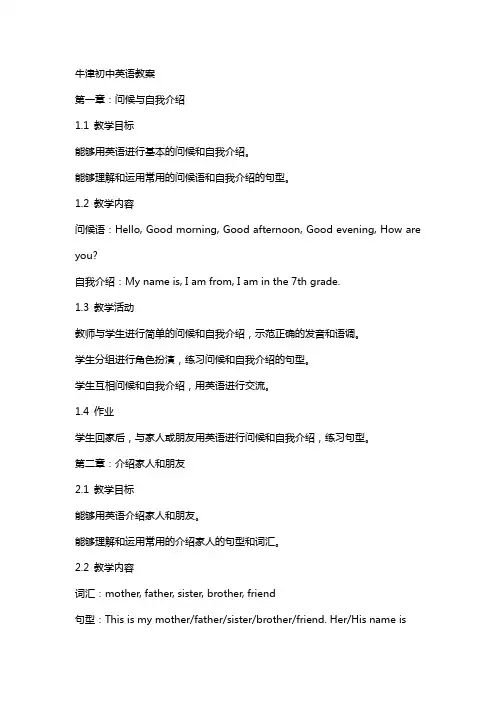
牛津初中英语教案第一章:问候与自我介绍1.1 教学目标能够用英语进行基本的问候和自我介绍。
能够理解和运用常用的问候语和自我介绍的句型。
1.2 教学内容问候语:Hello, Good morning, Good afternoon, Good evening, How are you?自我介绍:My name is, I am from, I am in the 7th grade.1.3 教学活动教师与学生进行简单的问候和自我介绍,示范正确的发音和语调。
学生分组进行角色扮演,练习问候和自我介绍的句型。
学生互相问候和自我介绍,用英语进行交流。
1.4 作业学生回家后,与家人或朋友用英语进行问候和自我介绍,练习句型。
第二章:介绍家人和朋友2.1 教学目标能够用英语介绍家人和朋友。
能够理解和运用常用的介绍家人的句型和词汇。
2.2 教学内容词汇:mother, father, sister, brother, friend句型:This is my mother/father/sister/brother/friend. Her/His name is2.3 教学活动教师通过展示图片或实物,教授词汇和句型。
学生进行角色扮演,练习介绍家人和朋友的句型。
学生互相介绍家人和朋友,用英语进行交流。
2.4 作业学生回家后,画一张家人的照片,并在旁边用英语写出每个人的名字和关系。
第三章:日常用品3.1 教学目标能够用英语描述日常用品。
能够理解和运用常用的描述物品的句型和词汇。
3.2 教学内容词汇:pen, pencil, eraser, book, ruler句型:This is a pen/pencil/eraser/book/ruler. It is3.3 教学活动教师通过展示实物,教授词汇和句型。
学生进行小组活动,练习描述日常用品的句型。
学生互相展示自己的日常用品,用英语进行交流。
3.4 作业学生回家后,找出自己的学习用品,并用英语描述它们的特征。
牛津初中英语教学案
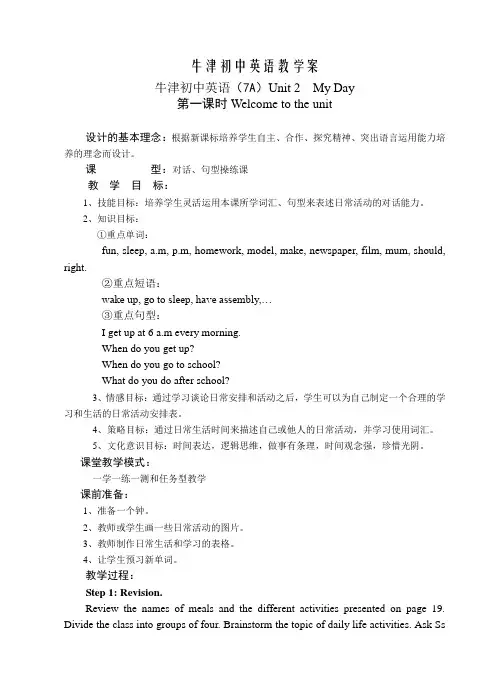
牛津初中英语教学案牛津初中英语(7A)Unit 2 My Day第一课时Welcome to the unit设计的基本理念:根据新课标培养学生自主、合作、探究精神、突出语言运用能力培养的理念而设计。
课型:对话、句型操练课教学目标:1、技能目标:培养学生灵活运用本课所学词汇、句型来表述日常活动的对话能力。
2、知识目标:①重点单词:fun, sleep, a.m, p.m, homework, model, make, newspaper, film, mum, should, right.②重点短语:wake up, go to sleep, have assembly,…③重点句型:I get up at 6 a.m every morning.When do you get up?When do you go to school?What do you do after school?3、情感目标:通过学习谈论日常安排和活动之后,学生可以为自己制定一个合理的学习和生活的日常活动安排表。
4、策略目标:通过日常生活时间来描述自己或他人的日常活动,并学习使用词汇。
5、文化意识目标:时间表达,逻辑思维,做事有条理,时间观念强,珍惜光阴。
课堂教学模式:一学一练一测和任务型教学课前准备:1、准备一个钟。
2、教师或学生画一些日常活动的图片。
3、教师制作日常生活和学习的表格。
4、让学生预习新单词。
教学过程:Step 1: Revision.Review the names of meals and the different activities presented on page 19. Divide the class into groups of four. Brainstorm the topic of daily life activities. Ask Ssto draw an activity if they do not know the word in English.Step 2: Presentation.Talk to Ss about daily routines and activities.Say: I get up at 6 a.m in the morning.When do you get up? etcStep 3: Ask Ss to sort their activities into different sections:Leisure — Sports — Eating — school.Teacher tells Ss to write down the day and time when they typically do these activities. As you go around the class, provide help with vocabulary.Step 4: Each group writes the four lists on the board. Ss can copy the activities they want to include in their diary.Step 5: Work in pairs to talk about their partner’s diary. You can use the following sentence patterns:a. When do you go to school /…/ ?b. Do you go to school by bus /…/ ?c. What do you do after school /…/ ?Step 6: Learn Vocabulary.a. P23 Go through Part A and read the words and phrases correctly. Attention to their pronunciation.b. Ss complete the task and check answers. Encourage Ss to memorize the collocations Part B.c. Let Ss go through Part B and explain the context. Ask Ss to do the task on their own, then check answers. Ss correct any mistakes and the teacher explains something if necessary.d. Divide the class into pairs. Let Ss read the conversation and get some pairs to act it out.Step 7: Practice — task.课堂教学任务。
牛津初中英语教案
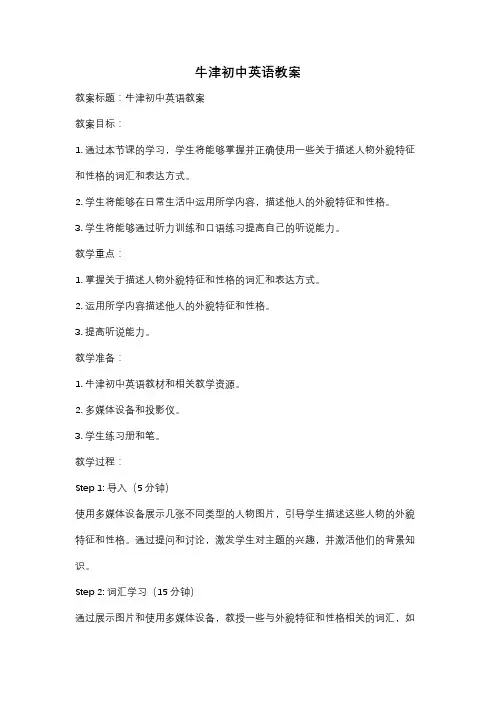
牛津初中英语教案教案标题:牛津初中英语教案教案目标:1. 通过本节课的学习,学生将能够掌握并正确使用一些关于描述人物外貌特征和性格的词汇和表达方式。
2. 学生将能够在日常生活中运用所学内容,描述他人的外貌特征和性格。
3. 学生将能够通过听力训练和口语练习提高自己的听说能力。
教学重点:1. 掌握关于描述人物外貌特征和性格的词汇和表达方式。
2. 运用所学内容描述他人的外貌特征和性格。
3. 提高听说能力。
教学准备:1. 牛津初中英语教材和相关教学资源。
2. 多媒体设备和投影仪。
3. 学生练习册和笔。
教学过程:Step 1: 导入(5分钟)使用多媒体设备展示几张不同类型的人物图片,引导学生描述这些人物的外貌特征和性格。
通过提问和讨论,激发学生对主题的兴趣,并激活他们的背景知识。
Step 2: 词汇学习(15分钟)通过展示图片和使用多媒体设备,教授一些与外貌特征和性格相关的词汇,如tall, short, long hair, curly hair, friendly, outgoing等。
教师可以提供中英文对照的词汇表,并进行适当的示范和操练。
Step 3: 句型练习(15分钟)教师通过示范和操练,引导学生使用所学词汇描述人物的外貌特征和性格。
学生可以进行配对练习,互相描述对方,或者以小组形式进行角色扮演,描述自己和他人。
Step 4: 听力训练(15分钟)使用教材中的听力材料,让学生听取关于人物外貌特征和性格的信息,并回答相关问题。
教师可以适当调整听力材料的难度,根据学生的水平进行分组听力训练。
Step 5: 口语练习(15分钟)学生根据教材中的口语练习要求,以小组形式进行对话练习。
教师可以提供一些情境和角色扮演的活动,让学生在实际交流中运用所学内容,提高口语表达能力。
Step 6: 小结和作业布置(5分钟)总结本节课的学习内容,并布置相关的作业,如完成练习册上的练习,或者写一篇关于自己或他人外貌特征和性格的短文。
牛津英语优秀教案初中
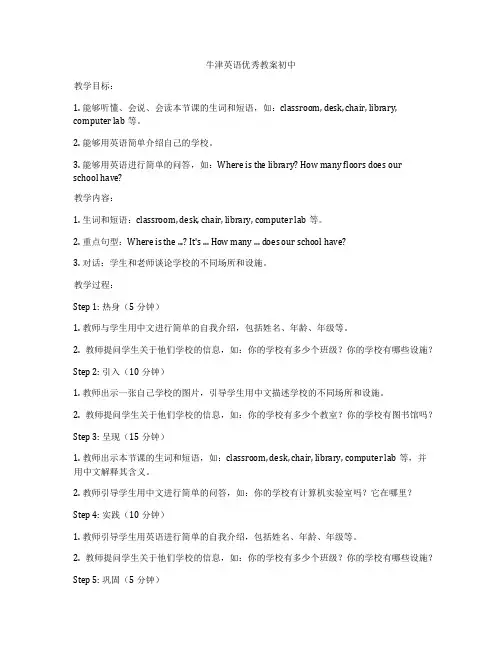
牛津英语优秀教案初中教学目标:1. 能够听懂、会说、会读本节课的生词和短语,如:classroom, desk, chair, library, computer lab等。
2. 能够用英语简单介绍自己的学校。
3. 能够用英语进行简单的问答,如:Where is the library? How many floors does our school have?教学内容:1. 生词和短语:classroom, desk, chair, library, computer lab等。
2. 重点句型:Where is the ...? It's ... How many ... does our school have?3. 对话:学生和老师谈论学校的不同场所和设施。
教学过程:Step 1: 热身(5分钟)1. 教师与学生用中文进行简单的自我介绍,包括姓名、年龄、年级等。
2. 教师提问学生关于他们学校的信息,如:你的学校有多少个班级?你的学校有哪些设施?Step 2: 引入(10分钟)1. 教师出示一张自己学校的图片,引导学生用中文描述学校的不同场所和设施。
2. 教师提问学生关于他们学校的信息,如:你的学校有多少个教室?你的学校有图书馆吗?Step 3: 呈现(15分钟)1. 教师出示本节课的生词和短语,如:classroom, desk, chair, library, computer lab等,并用中文解释其含义。
2. 教师引导学生用中文进行简单的问答,如:你的学校有计算机实验室吗?它在哪里?Step 4: 实践(10分钟)1. 教师引导学生用英语进行简单的自我介绍,包括姓名、年龄、年级等。
2. 教师提问学生关于他们学校的信息,如:你的学校有多少个班级?你的学校有哪些设施?Step 5: 巩固(5分钟)1. 教师出示一张学校地图,引导学生用英语描述学校的不同场所和设施。
2. 教师引导学生进行小组活动,用英语进行问答,如:Where is the library? How many floors does our school have?Step 6: 总结(5分钟)1. 教师用中文总结本节课所学的生词和短语,如:classroom, desk, chair, library, computer lab等。
牛津初中优秀教案英语
牛津初中优秀教案英语一、教学目标1. 知识目标(1)能够理解课文内容,掌握相关词汇和短语。
(2)能够运用所学的句型和语法进行口头和书面表达。
2. 能力目标(1)培养学生的听力技能,提高学生理解和获取信息的能力。
(2)培养学生的口语表达能力,使学生能够流利地用英语进行交流。
3. 情感目标(1)激发学生学习英语的兴趣,增强学生的自信心。
(2)培养学生合作学习的精神,提高学生的团队协作能力。
二、教学内容本课的教学内容是牛津初中英语教材中的一个单元,主题是关于青少年生活中的日常活动。
通过学习课文,学生能够了解青少年常见的活动,如学习、运动、娱乐等,并能够运用所学的词汇和句型进行相关话题的交流。
三、教学过程1. 导入(5分钟)通过与学生进行简单的英语对话,激发学生的学习兴趣,并引导学生进入本课的主题。
2. 新课呈现(15分钟)(1)教师通过展示图片或实物,引导学生学习本课的新词汇和短语。
(2)教师通过PPT或板书,展示本课的主要句型和语法结构。
(3)教师引导学生进行听力练习,让学生听懂并能够理解和运用所学的词汇和句型。
3. 课堂活动(20分钟)(1)小组活动:学生分组进行角色扮演,运用所学的词汇和句型进行对话,模拟青少年生活中的日常活动。
(2)个人活动:学生根据所给的题目,用所学的词汇和句型写一段短文,描述自己的日常活动。
4. 巩固练习(10分钟)教师通过发放练习册或提供练习题,让学生进行书面练习,巩固所学的词汇和句型。
5. 总结与作业布置(5分钟)教师对本课的主要内容进行总结,布置相关的作业,让学生回家后复习和巩固所学知识。
四、教学评价1. 课堂参与度:观察学生在课堂上的积极参与程度,如发言、回答问题、互动等。
2. 作业完成情况:检查学生完成作业的质量,如拼写、语法、表达等。
3. 口语表达能力:评估学生在角色扮演和口头表达中的流利程度和准确性。
通过以上评价,教师能够了解学生的学习情况,及时调整教学方法和策略,提高教学质量。
江苏牛津英语初中教案
江苏牛津英语初中教案一、教学目标1. 知识目标(1)能够掌握本课的生词和短语。
(2)能够理解课文的主要内容和情节。
(3)能够运用所学的句子和短语进行口语表达和写作。
2. 能力目标(1)能够提高学生的听力理解能力。
(2)能够提高学生的阅读理解能力。
(3)能够提高学生的口语表达能力和写作能力。
3. 情感目标(1)激发学生学习英语的兴趣和积极性。
(2)培养学生的团队合作意识和互助精神。
二、教学内容1. 课文主题:本课的主题是关于环境保护和可持续发展的故事。
2. 课文内容:故事发生在一个小镇上,人们滥用资源,导致环境恶化。
后来,小镇的居民意识到问题的严重性,开始采取行动来保护环境,实现了可持续发展。
3. 生词和短语:本课的生词和短语包括:environmental protection, sustainable development, take action, pollution, resource conservation等。
三、教学过程1. 导入:通过图片和问题引导学生思考环境问题,激发学生的学习兴趣。
2. 读前活动:让学生预测故事情节,激发学生的阅读兴趣。
3. 阅读活动:让学生分组阅读课文,回答问题,增强学生的阅读理解能力。
4. 听力活动:播放课文听力材料,让学生回答问题,提高学生的听力理解能力。
5. 口语活动:让学生分组讨论环境保护的重要性,并进行角色扮演,提高学生的口语表达能力。
6. 写作活动:让学生根据课文内容写一篇关于环境保护的短文,提高学生的写作能力。
7. 总结和反馈:对学生的学习情况进行总结和反馈,鼓励学生继续努力。
四、教学资源1. 课文文本。
2. 课文听力材料。
3. 与课文主题相关的图片和视频。
4. 生词和短语的释义和例句。
五、教学评价1. 对学生的听力、阅读、口语和写作能力进行评价。
2. 对学生的团队合作意识和互助精神进行评价。
3. 对学生的学习兴趣和积极性进行评价。
六、教学建议1. 鼓励学生在课堂上积极发言,提高学生的口语表达能力。
牛津初中英语教学设计
牛津初中英语教学设计教学目标:1.学生能够掌握基本的英语词汇和语法知识。
2.学生能够运用所学的英语知识进行日常交流和简单的应用。
3.学生能够通过听、说、读、写等多种方式提高英语综合应用能力。
4.学生通过合作学习培养团队合作和沟通能力。
教学内容:教材:牛津初中英语教材单元:Unit 1 : Hello教学重点:1.学习基本的自我介绍和问候语。
2.学习数字、颜色和国家等基本生活信息和知识。
3.学习简单的日常用语和表达方式。
教学难点:学生能够运用所学知识进行简单的听、说、读、写练习。
教学准备:1.教师准备课件、教材、多媒体设备等教学工具。
2.学生准备课本、笔和纸等学习用品。
教学过程:Step 1: Lead-in (引入)通过图片和视频展示各个国家的风俗、音乐、服装等,调动学生的学习兴趣,并出示课程目标和教学要求。
Step 2: Vocabulary Presentation (词汇呈现)教师通过图片和实物等方式呈现和讲解各种常用的问候语、数字、颜色和国家名称等。
并请学生跟读和模仿。
Step 3: Vocabulary Practice (词汇练习)1.教师分发练习卡片,让学生自己读出表达各种问候语、数字、颜色和国家名称的正确发音。
2.学生两人一组,互相问候并使用所学的词汇进行对话练习。
3.教师进行集体检查,对学生的发音和对话进行评价和指导。
Step 4: Listening and Speaking (听说)教师播放课文录音,学生跟读并模仿录音中的语音语调和重音。
然后教师提问学生关于课文的问题,鼓励学生利用所学的词汇进行回答。
Step 5: Reading and Writing (读写)1.分发阅读材料并让学生自己默读和理解材料内容。
2.学生两人一组,通过互相提问的方式来测试对材料内容的理解并进行回答。
3.学生根据所学的知识写一篇关于自己的简短介绍,包括姓名、年龄、国籍、兴趣爱好等,并请学生将作文在班级内互相交流和修改。
牛津初中英语教案
牛津初中英语教案第一章:问候与自我介绍1.1 教学目标学会用英语进行基本的问候和自我介绍。
能够听懂并正确回答关于姓名、年龄、国籍等问题。
掌握简单的英语日常用语,如“Hello”,“How are you?”,“My name is”等。
1.2 教学内容问候与自我介绍的基本用语。
常用的日常英语表达。
1.3 教学步骤教师与学生进行简单的英语问候,引导学生进入学习状态。
学生两人一组,进行自我介绍练习。
教师提供一些常用词汇,如“name”,“age”,“country”等,引导学生进行问答练习。
1.4 作业学生回家后,与家人或朋友用英语进行简单的问候和自我介绍。
第二章:介绍家人和朋友2.1 教学目标学会用英语介绍家人和朋友。
能够听懂并正确回答关于家人和朋友的问题。
掌握简单的英语表达,如“This is my mother”,“She is a teacher”等。
2.2 教学内容介绍家人和朋友的英语表达。
常用的英语疑问词,如“Who”,“What”,“Where”等。
2.3 教学步骤教师与学生进行简单的英语对话,引导学生进入学习状态。
学生两人一组,进行介绍家人和朋友的练习。
教师提供一些图片或词汇,如“mother”,“father”,“brother”等,引导学生进行问答练习。
2.4 作业学生回家后,用英语写一篇关于自己家人的短文。
第三章:介绍学校和课程3.1 教学目标学会用英语介绍学校和课程。
能够听懂并正确回答关于学校和课程的问题。
掌握简单的英语表达,如“I study English”,“My school is big”等。
3.2 教学内容介绍学校和课程的英语表达。
常用的英语疑问词,如“What”,“Where”,“Why”等。
3.3 教学步骤教师与学生进行简单的英语对话,引导学生进入学习状态。
学生两人一组,进行介绍学校和课程的练习。
教师提供一些图片或词汇,如“school”,“classroom”,“subject”等,引导学生进行问答练习。
- 1、下载文档前请自行甄别文档内容的完整性,平台不提供额外的编辑、内容补充、找答案等附加服务。
- 2、"仅部分预览"的文档,不可在线预览部分如存在完整性等问题,可反馈申请退款(可完整预览的文档不适用该条件!)。
- 3、如文档侵犯您的权益,请联系客服反馈,我们会尽快为您处理(人工客服工作时间:9:00-18:30)。
9A Unit 3 Main task泰兴市姚王镇中心初中任祥元一、教学分析(Teaching analyses)1.教学内容:9A Unit 3 Main task ,该节课的内容是该单元的第九课时。
学生学习和了解一些压力形成的原因以及一些基本的解决办法,并就压力问题写一封信。
2.学生情况:已学过本单元的课文和用法内容,基本上掌握了一些重要的表达句型。
二、教学目标(Teaching aims)1、回答调查中的问题2、学会在写信之前先写提纲3、就压力问题写一封信三、教学重点、难点blame cause shout at of one’s age keep sth to oneself四、教学步骤(Teaching procedures)Step1 Lead in(1) Give the students an English song called Sunshine on my shoulders to enjoy.(2) Show two pictures to the students. One is a sunny day and the other is a windyday. The teacher says: Everybody hopes his life is full of sunshine , but sometimes he has grey sky. These days, in my son’s eyes, the sky is grey.What’s the trouble?(3) Listen to my son’s trouble. (My son’s words: I am a little weak in maths. Ioften make a lot of mistakes in maths. Sometimes I fail in maths tests. I am afraid of maths and I hate maths.)(设计意图:由一曲英文歌导入,即创造出和谐的氛围,同时也自然呈现bright sky、grey sky, 为后面任务布置做下铺垫。
通过教师儿子的问题创设情景,引导学生通过倾听去探究老师儿子的压力所在,任务设计真实,与学生生活联系紧密,能激发学生的兴趣,激活学生知识储备。
)Step 2 Assign a small task(1)T: What is the cause of his stress? (Make sure the students understand themeaning of the word “cause”)(2)T: Do you know how to help him? Elicit from the students the ways to deal withthe problems.( on the blackboard) the cause of stress / how to deal with itT: My son is a boy of your age. I think it’s easier for him to accept your advice.Encourage the students to help the teacher’s son using words.(3)T: Just now you gave my son a lot of advice, are they useful? Listen to my son’sresponse.(Play the recording) The teacher’s son’s words: Thanks for your valuable advice.I feel much better now. I decide to try my best to improve my maths.)(设计意图:引导学生思考如何帮助处于压力中的人,引导学生学会找到解决任务的策略。
这一任务设计切口较小,激活学生原有的经验及知识,任务较开放,学生可以从多角度回答,从而培养了学生的求异思维。
能使各个学生充满自信地参与完成,并在完成任务的过程中体验到成功的喜悦。
)Step3 Analyze the answers to the task to focus on language(1)Encouraging words:Don’t lose heart. It’s not the end of the world.Don’t give up. I believe everything will be OK.Nothing is difficult if you put your heart into it.It’s common for teenagers to have stress. Nobody is perfect.Be confident! Nobody can be good at everything!(2)Specific advice:You should listen to the teacher more carefully in class.Why not spend more time on maths?My advice is to ask the maths teacher for help.One way to deal with the problem is to do some extra maths homework.Read the maths problems more slowly and carefully.Be careful not to make mistakes when you do your maths homework.You can ask your friends for some advice on how to learn maths.(设计意图:通过任务聚焦,引导学生归纳、总结如何给他人提供建议。
由语意的理解、交流转入语言功能、形式的操练,为学生更多的语言素材的积累,保证任务型英语课堂教学更扎实、有效。
)Step 4 Cooperate to finish another small taskT: Thanks for encouraging my son and giving him so much advice. I think you are like the Youth worker---Sigmund here, why not speak out your worries/ It’s a good chance for you to get some valuable advice. Come on! It’s common for speak out some of their problems and offer some useful advice.(设计意图:在师生合作学习、完成前一个小任务的过程中,学生们已经掌握了如何寻求帮助、如何提供帮助的功能。
教师趁热打铁又布置了个任务链中的小任务,鼓励学生说出自己的一些成长中的烦恼,向其他同学求助。
学生们学以致用,结合自己的经验,畅所欲言,多角度地提出自己的方法。
在完成任务的过程中,学生们学会了合作,提高了英语运用能力,在完成任务的过程中,学生们学会了合作,提高了英语运用能力,在完成任务的过程中体验到了的喜悦。
)Step 5 Analyze the causes of stressT: You are suffering from so much stress because of different causes. Luckily, you’ve got so much advice. Sharing stress is wonderful! So many causes are complicated. Can you divide them into several aspects? For example: Some students feel stressed because of too much homework, too many tests, less time for hobbies. In these situations, stress comes from schoolwork. Elicit from the students the different kinds of causes: 1 schoolwork 2 parents 3 friends 4 students themselves 5 teachers(设计意图:在学生们完成“说出烦恼,共商解决办法”小任务的前提下,利用图表引导学生进行压力原因的分类,此举有助于学生理清头绪,将知识进行分析、汇总、融合,同时也达到任务后学生聚焦语言的目的。
)Step 6 Do a quiz(1)T: Old problems have gone, new problems will come. It’s natural. Next timewhen you have problems, what will you do? You have 3 choice answers. Circle the best answer and tell the reason, try to think of some other advice.A keep worries to yourselfB speak out worriesC feel ashamed(2) T: If you put a lot of questions like this with choice answers together and write them on the piece of paper, we get a quiz. Mr. Wu has given his students a quiz to find out whether his students know how to deal with stress. Can you help them do the quiz? (Complete the quiz in the book)(3) Complete the quiz in pairs or in groups.(设计意图:通过教学设计引导学生了解quiz如何构成,为学生能自己设计quiz 提供了素材。
